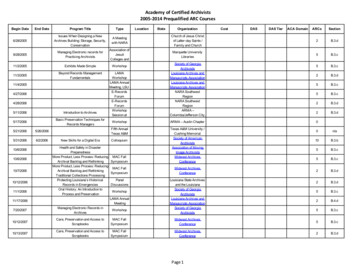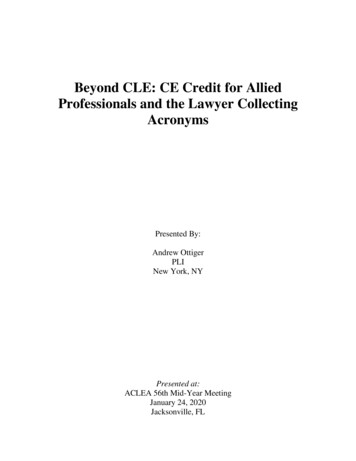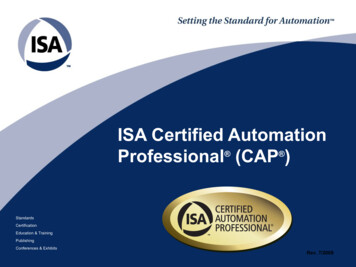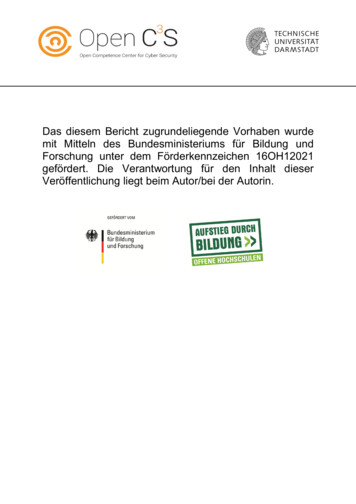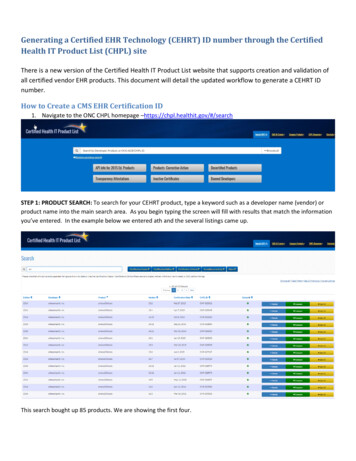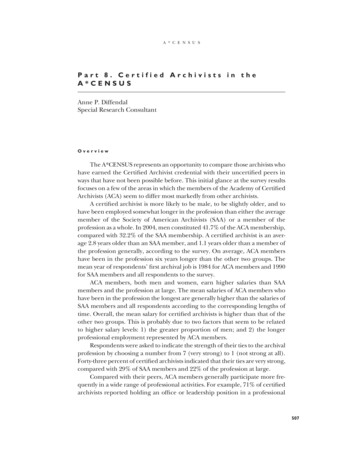
Transcription
SOAA FW0524/11/0711:35 AMPage 507A * C E N S U SPart 8. Certified Archivists in theA*CENSUSAnne P. DiffendalSpecial Research ConsultantOverviewThe A*CENSUS represents an opportunity to compare those archivists whohave earned the Certified Archivist credential with their uncertified peers inways that have not been possible before. This initial glance at the survey resultsfocuses on a few of the areas in which the members of the Academy of CertifiedArchivists (ACA) seem to differ most markedly from other archivists.A certified archivist is more likely to be male, to be slightly older, and tohave been employed somewhat longer in the profession than either the averagemember of the Society of American Archivists (SAA) or a member of theprofession as a whole. In 2004, men constituted 41.7% of the ACA membership,compared with 32.2% of the SAA membership. A certified archivist is an average 2.8 years older than an SAA member, and 1.1 years older than a member ofthe profession generally, according to the survey. On average, ACA membershave been in the profession six years longer than the other two groups. Themean year of respondents’ first archival job is 1984 for ACA members and 1990for SAA members and all respondents to the survey.ACA members, both men and women, earn higher salaries than SAAmembers and the profession at large. The mean salaries of ACA members whohave been in the profession the longest are generally higher than the salaries ofSAA members and all respondents according to the corresponding lengths oftime. Overall, the mean salary for certified archivists is higher than that of theother two groups. This is probably due to two factors that seem to be relatedto higher salary levels: 1) the greater proportion of men; and 2) the longerprofessional employment represented by ACA members.Respondents were asked to indicate the strength of their ties to the archivalprofession by choosing a number from 7 (very strong) to 1 (not strong at all).Forty-three percent of certified archivists indicated that their ties are very strong,compared with 29% of SAA members and 22% of the profession at large.Compared with their peers, ACA members generally participate more frequently in a wide range of professional activities. For example, 71% of certifiedarchivists reported holding an office or leadership position in a professional507
SOAA FW0524/11/0711:35 AMPage 508TH EAM E R I C A NAR C H I V I S Tassociation at some time during the course of their careers, while 51.1% of SAAmembers and 43.3% of the profession at large reported this type of service.Certified archivists also participate in archives-related continuing education in proportionately greater numbers than do SAA members and membersof the profession generally. On a list of various kinds of continuing educationand training, the percentage of ACA members who reported participatingranked highest in thirteen of the seventeen categories, when compared withSAA members and all respondents to the survey.The greater strength of ties to the profession, higher levels of professionalactivity, and greater participation in continuing education extend across therange of years of experience, from newly certified archivists to the most experienced. The data do not reveal possible explanations—whether the effortof studying for the examination and maintaining certification engenders theselevels of affinity and activity, or if individuals who are already very attached to orinvolved in the profession are more likely to pursue certification.Archival managers were asked to rank nine qualifications according to theirimportance when hiring entry-level archivists, and also mid-level or seniorarchivists. Certification ranked as the least important of the qualifications forboth questions in answers from all respondents, as well as from SAA membersand from archival managers who were certified. Here, also, the data do notexplain the reasons. Were the managers reflecting their personal opinions? Ordo their answers reflect the hiring policies and practices at their institutions,situations over which they may have little or no control?Future surveys might usefully inquire about the reasons and motivations forrespondents’ answers.IntroductionThe overwhelming volume of data in the A*CENSUS will provide the basisfor analysis and interpretation of the archival profession for many years to come.For example, the A*CENSUS represents an opportunity to compare archivistswho have earned the CA credential with their uncertified peers in ways that havenot been possible before. After a brief account of the development of thearchival certification program, this initial glance at the survey results focusesprimarily on a few of the areas in which the members of the Academy ofCertified Archivists seem to differ most markedly from other archivists.Certification in GeneralCertification is the process by which an association or nongovernmental organization recognizes the competency of an individual who has met predetermined508
SOAA FW0524/11/0711:35 AMPage 509A * C E N S U Squalifications specified by that association or organization. The term “certification” is usually applied to the evaluation of an individual’s competence; “accreditation” usually refers to a measurement of a program’s or an organization’sperformance. Occasionally the terms are used interchangeably, thereby creatingsome confusion.Certification refers to a voluntary process. The term “licensing” or “licensure” is used for a governmental system of regulation for the purpose of publicprotection. Licensure confers upon an individual the legal authority to practicean occupation or profession.Although certification is voluntary and licensing is a matter of law, theprocesses and procedures followed in certifying and licensing individual practitioners are quite similar. In the United States, these procedures have been developed over more than a century of experience and honed through court challenges.The proliferation of professional specialties, a mobile population, andrapid technological development have intensified the demand for nationallyrecognized methods of identifying competence in a wide range of disciplines.Most certification programs have been developed by national associations,although some have evolved without an existing organizational base. Othershave been created within business and industry.Certification programs usually develop when the leadership in a particulardiscipline finds the need to articulate standards of performance and assure compliance with these standards to protect the public, assist employers, and increasethe credibility of the discipline. Sometimes competition and, occasionally,threat of government intervention or legal action are motivating factors.Standards have been developed for certification programs and a nationalorganization formed to accredit certifying organizations. A sound certificationprogram must begin with a thorough role study or job analysis of the professionor occupation to be certified. The result is a document that serves as the basisfor the examination or the performance measurement system used to certifyindividuals. There are standards for developing the examination, recommended procedures for establishing the certifying organization, and criteria forundertaking a certification maintenance program, referred to as “recertifying.”The persons involved in developing and conducting the archival certificationprogram have chosen to follow recommended best practices in certification.Archival CertificationDuring the 1980s, amid a growing acceptance of the need for standards,intense discussions took place within the Society of American Archivists aboutthe meaning of professionalism as it relates to archival practice. These discussions included consideration of the three means by which the competency of509
SOAA FW0524/11/0711:35 AMPage 510TH EAM E R I C A NAR C H I V I S Tprofessional practitioners can be ascertained: accrediting the institutions inwhich professionals work, accrediting the educational programs in which professionals are trained, and certifying individual practitioners. The first methodis undertaken by museum professionals and the second by librarians; teachingand medical professions employ all three.Various constituencies within SAA debated and investigated how such programs might be applied to archivists. By the end of the decade, the associationhad acted in some fashion on all three of them.1In 1982, SAA published the booklet, Evaluation of Archival Institutions:Services, Principles, and Guide to Self-Study, which outlined a method for examiningthe goals and plans and offered seven principles for evaluating the performanceof an archival institution. An Archives Assessment and Planning Workbook (1989)provided a step-by-step guide to conducting the assessment in order to produceinformation about institutions in a standard form to facilitate comparisons.The number of archivists teaching in graduate-level programs, including ahandful with full-time appointments, increased during the 1980s. These archivaleducators led the discussions about upgrading and standardizing the curriculum content, as well as about establishing a formal accreditation program on themodel of the American Library Association. The immediate outcome was theadoption by the SAA Council in 1988 of “Guidelines for Graduate ArchivalEducation Programs.” This document substantially upgraded the program recommended in the earlier “Guidelines for a Graduate Minor or Concentrationin Archival Education” (1978).Arguably, the constituency within SAA that was interested in pursuing aprogram of certifying individuals was less vocal and less organized than constituencies interested in the other options, certainly less so than the archivaleducators. Nevertheless, certification was investigated as part of the focus onways to develop the profession. Although it could issue guidelines and recommendations, SAA did not itself have the authority to establish accreditingprograms for university graduate education or for archival institutions. Suchprograms are generally developed and maintained by the institutions involved,or with their support. However, as an association of individual practitioners, SAAcould establish a program for certifying archivists.Archival Certification: The BeginningsTo begin, the SAA Council contracted for consultant services withProfessional Examination Service (PES), a firm experienced in developing and1510Information on the course of these discussions and their results can be found in the SAA Newsletter; inreports to the SAA Council from the various committees, boards, and task forces involved; and in theprefatory material of the resulting publications.
SOAA FW0524/11/0711:35 AMPage 511A * C E N S U Smanaging professional certification programs. With the appointment of theInterim Board for Certification (IBC) in 1987, the Council determined to proceedwith archival certification. Acting on the advice of PES, the IBC followed thenationally accepted means of developing a program that included conducting arole study of archival practice and undertaking the initial phases of certificationby petition and examination.2In order to secure a sufficient membership and a financial base of support,nearly all new professional certification programs offer initial certification by petition, so-called “grandfathering.” The IBC followed precedent in this regard. Fora limited period of time, individuals could apply to become certified by presenting evidence of qualifying education and experience as a professional archivist.The combination of education and experience required for initial archival certification was any one of the following: a master’s degree, including graduate studyof archives administration, and a minimum of five years of qualifying professionalarchival experience; or a master’s degree and six years of qualifying professionalarchival experience; or a bachelor’s degree and seven years of qualifying professional archival experience. Initial certification by petition was available fromOctober 1, 1988, to September 30, 1989, for those applicants who qualified.For individuals not having sufficient qualifying experience, an examinationwas developed. The first certification examination was offered at the 1989 SAAAnnual Meeting. Fewer years of experience were required in each of the degreecategories for applicants who took the examination, compared with certificationby petition.The initial class of 1989 included 689 individuals who certified by petitionand twenty individuals who became certified by passing the examination (out oftwenty-one who sat for the exam).According to plan, at that 1989 SAA Annual Meeting, which took place inSt. Louis, the Interim Board for Certification was dissolved. Those present at themeeting who had been certified by petition formed a new association, theAcademy of Certified Archivists. This organization, whose membership comprises all currently certified archivists in good standing, is an incorporated,not-for-profit body that is independent of the Society of American Archivists.Initially the ACA contracted with PES to oversee exam development andprovide advice on the continuing development of the certification program,and with the Society of American Archivists for management services, includingmaintenance of the membership database and publication of a newsletter. In2The beginnings and subsequent development of archival certification can be traced first in the SAANewsletter and then in the ACA Newsletter, which until 1995 was published as an insert in the former anddistributed to all SAA members. Historical as well as current information about the Academy of CertifiedArchivists can be found on its website, www.certifiedarchivists.org. Included on the website arearticles about the early years of the academy by three of its early leaders, Gregory Hunter, MaygeneDaniels, and Elizabeth Adkins.511
SOAA FW0524/11/0711:35 AMPage 512TH EAM E R I C A NAR C H I V I S T1995 the ACA engaged Capitol Hill Management to provide management andpsychometric services.Initial Certification: Qualifying to Take the ExaminationSince the close of the period of initial certification by petition, everyoneseeking to become a certified archivist must pass the examination. Requirementsto stand for the exam have changed somewhat. The bachelor’s degree has beeneliminated. Currently, to take the examination a candidate must present either(1) a master’s degree with a concentration in archival administration (at leastnine semester hours or twelve quarter hours of graduate coursework), plus oneyear of qualifying professional archival experience; or (2) a master’s degreewithout a concentration in archival administration, plus two years of qualifyingprofessional archival experience.A third option is intended for recent graduates of archival educationprograms. It requires a master’s degree with at least nine semester hours ortwelve quarter hours of graduate study in archival administration. Individualswho pass the exam under this option may become certified upon presentingevidence of at least one year of qualifying professional archival experiencewithin the following three years.Maintaining CertificationFrom the beginning, archival certification included a requirement forindividuals to maintain their certification by periodically demonstrating thatthey had kept up with current developments in the field. The ACA adopted specific guidelines for certification maintenance in 1992; the program was implemented in 1997. Academy members must verify their certification maintenanceactivities every five years to retain the designation of Certified Archivist.Members may choose to “recertify” (as the process is commonly called) inone of two ways. They may pass the current examination. Or they may recertifyby petition, which uses a point system to recognize continuing education, contributions to the profession, and experience during the previous five-yearperiod. The majority of members use the petition method; however, some recertify by examination every year. In 2004, for example, fifty-three individualssubmitted petitions, while ten took the exam.Previous Surveys of Certified ArchivistsThe Academy of Certified Archivists surveyed its members in 1989 andagain in 1999. The second survey used the same questions, so as to be able to512
SOAA FW0524/11/0711:35 AMPage 513A * C E N S U Scompare results, with a few additional ones. For the A*CENSUS, no attemptwas made to duplicate these earlier questions, nor were there any specificquestions asked only of ACA members. Even where the questions were similar,such as those on age and salary, the categories for A*CENSUS responses arenot identical to those in the previous ACA surveys. Consequently, directcomparisons among the three sets of responses are difficult for most questions.In a few areas, however, some comparisons are possible and will be attemptedhere.3In 1989, 709 questionnaires were mailed and 689 were returned, for aresponse rate of 97%. In 1999, 624 questionnaires were mailed and 444 werereturned, for a response rate of 71%. The A*CENSUS received 593 responsesfrom 765 ACA members, for a response rate of 77.5%.Certified Archivists in the A*CENSUSAll members of the Academy of Certified Archivists are certified archivists;all certified archivists are members of the Academy. Whenever the A*CENSUSdata are reported according to membership in professional associations, thefigure for ACA membership is the number of respondents who identified themselves as members of ACA. Thus this figure also represents the number ofcertified archivists who responded to questions on the survey.The following comparisons of certified archivists with their peers are madeusing the three categories—ACA members, SAA members, and all respondents.As mentioned above, in the A*CENSUS survey, 593 individuals indicated membership in ACA, out of the total of 765 on the mailing list of members provided tothe A*CENSUS project, for an overall response rate of 77.5%. For SAA, 2,409 outof 2,913 on the SAA list that was provided for the survey indicated SAA membership, for a response rate of 82.7%. Overall, an official total of 5,620 respondingindividuals, out of just under 12,000 names compiled from the various membership and mailing lists, took the survey. The official response rate was 47.18%(Table 1.4).Because not everyone completed the entire survey, the numbers andrates of responses to individual questions differ. When responses to two (ormore) questions are combined for analysis, only the answers from thosewho answered both (or all of the) questions are included in the analysis thatfollows.3A summary of the 1999 survey, along with some comparisons to the results from 1989, are located onthe ACA website. The returns from both surveys are in the ACA archives in the Golda Meir Library atthe University of Wisconsin-Milwaukee.513
SOAA FW0524/11/0711:35 AMPage 514TH EAM E R I C A NAR C H I V I S TSome Demographic FeaturesA certified archivist is more likely to be male, to be slightly older, and tohave been employed somewhat longer in the profession than either the averageSAA member or member of the profession as a whole.GenderInformation on gender available from earlier surveys of SAA members suggests a significant shift over the past fifty years, from 67.0% men in 1956 to 66.9%women in 2004 (Fig. 8.1, SAA gender shift, 1956-2004, at www.archivists.org). Inthe past fifteen years, ACA has also seen a gender shift, but less than that of SAA.The first survey of ACA in 1989 revealed a membership almost evenly dividedbetween men (50.0%) and women (49.9%) (Fig. 8.2, ACA gender shift, 19892004, at www.archivists.org). By 2004, the percentage of women was greater(58.3%). Today, the proportion of men among ACA members (41.7%) isapproximately 30% greater than among SAA members (32.2%), and about 20%greater than among all respondents to the A*CENSUS (34.5%).Age and Length of Time in the ProfessionAn ACA member is an average 2.6 years older than an SAA member, and1.1 years older than a member of the profession generally. On average, ACAmembers have been in the profession six years longer than the other two groups.The mean year of respondents’ first archival job is 1984 for ACA members, and1990 for SAA members and all respondents (Table 8.1).Forty-eight percent of ACA members reported taking their first archival jobtwenty or more years ago, compared to 30% for SAA members and 28% for allTable 8.1. Approximate mean salaries by gender, mean age, and mean year of first archivaljob – ACA, SAA, all respondentsApproximate mean* salary by gender, mean age, and mean year of first archival jobMaleFemaleTotalMean ageMean year of 1st archival jobACASAAAll Respondents 60,548 51,103 55,21849.8 years1984 57,629 47,864 51,27947.2 years1990 54,787 46,151 49,32948.7 years1990Notes: Total n ACA – 482;SAA – 1,838;All – 3,817. [Figures are from “Salary Data from the A*CENSUS, PreliminaryReport #2,” December 10, 2004. Tables 2, 5, and 6.] *See Appendix D for process used to calculate approximate meansfor questions using ranges in the A*CENSUS.514
SOAA FW0524/11/0711:35 AMPage 515A * C E N S U Srespondents (Fig. 8.3, Year of first archival job – ACA, SAA, all respondents, atwww.archivists.org).ACA members should be expected to average a somewhat longer time inthe profession than their peers, because certification requires at least one or twoyears of experience. On the A*CENSUS, 10% of the SAA membership and 9%of all respondents reported less than three years since their first archival job,compared to 1% of certified archivists.SalaryACA members, men and women as well as respondents overall, earn highersalaries than SAA members and the profession at large (Table 8.1).Salary is related to length of time in the profession. Archivists who indicatedthat they began their first archival job before 1970 reported the highest salaries.The average salary level declines as the length of time in the professiondecreases (Table 8.2, Approximate mean salaries by year of first archivaljob – ACA, SAA, all respondents, in Appendix L).515
SOAA FW0524/11/0711:35 AMPage 516TH EAM E R I C A NAR C H I V I S TSalary level is also related to gender. At every five-year range for year offirst archival job, the average salaries of men are greater than those of women(Table 3.6.3, Approximate mean salaries, by year in which respondents startedfirst archival job, all respondents, men, and women, in Appendix H).The mean salaries of those ACA members who have been in the professionthe longest are generally higher than the salaries of SAA members and allrespondents for the corresponding lengths of time. Overall, the mean salaryfor certified archivists is highest of the three groups (Table 8.2). This could bebecause there are proportionally more men among ACA members, andbecause, on average, ACA members took their first archival jobs six years earlierthan did their peers (Table 8.1).Professional MembershipTo what other associations do certified archivists belong?In 2004, 79.1% of certified archivists reported belonging to the Society ofAmerican Archivists (Table 3.9.13a, Membership overlap among national and516
SOAA FW0524/11/0711:35 AMPage 517A * C E N S U Sregional archival associations, in Appendix H). The 1999 ACA survey resultswere similar to those in the A*CENSUS in 2004, with 79% of ACA members alsobelonging to SAA in the 1999 survey. A question about SAA membership was notasked in the 1989 ACA survey.In 2004, 22.3% of ACA members were also members of the Mid-AtlanticRegional Archives Conference (MARAC); 22.6% belonged to the MidwestArchives Conference (MAC); 20.2% belonged to the Society of SouthwestArchivists (SSA); and a reported 6.7% belonged to the New England Archivists(NEA) (Table 3.9.13a). Questions and answers on regional membership inprevious ACA surveys allow for comparisons involving these four associations(Table 8.3). The figures for membership in the Southwest organization havedoubled, while those for the New England group have held fairly steady.How many members of other associations are also certifiedarchivists?In the A*CENSUS, 19.5% of SAA members reported belonging to ACA(Table 3.9.13b, Membership overlap among national and regional archival associations, in Appendix H). The two largest regional organizations, MARAC andMAC, show similar results. Participation in the certification program appears517
SOAA FW0524/11/0711:35 AMPage 518TH EAM E R I C A NAR C H I V I S TTable 8.3. ACA members in certain regional archival associationsACA members in certain regional archival associationsACA members also members 5.3%06.8%1321341204022.6%22.6%20.2%06.7%Notes: 1989 – n 689; 1999 – n 444; 2004 – n 593.* In the 1989 and 1999 surveys, the area was reported as SW, but it seems to encompass the area now included in theSociety of Southwest Archivists (SSA).strongest among members of organizations in the Southwest, inter-mountainWest, and Northwest, and seems weakest in the New England and Californiagroups (Tables 3.9.13a, 3.9.13b, 3.9.13c, and 3.9.13d, in Appendix H).Participation in Archival Certification Compared withOther ProfessionsHow do we evaluate the report of 19.5% of SAA members that they arecertified archivists? One way is to look at other professions with voluntarycertification programs (Table 8.4).Unfortunately, the others have not recently conducted surveys such as theA*CENSUS. The figures that are available to allow comparisons among different professions are the total number of certified individuals and the number ofindividual members of the national professional associations. For the archivalprofession, the comparable figures are the numbers of members of ACA andSAA, respectively, and not the responses to the A*CENSUS. For the 2004 survey,the Academy of Certified Archivists submitted a list of 765 members and theSociety of American Archivists a list of 2,913. From those figures, the proportionof SAA members who are ACA certified is 26% (Table 8.4).According to a list of other professional associations and their ratesof voluntary certification, it would appear common for voluntary certificationprograms to encompass far less than a majority of practitioners within aprofession. The rates for the group of professions listed in Table 8.4 rangefrom 7% to 32%, with archivists falling somewhere in the middle, at 26%.Although these figures are approximate in some instances, they do give someperspective.518
SOAA FW0524/11/0711:35 AMPage 519A * C E N S U STable 8.4. Number certified in selected professionsNumber certified in selected professionsCertification AssociationAcademy of Certified ArchivistsInstitute of Certified Records ManagersCertified Association Executive ProgramAcademy of Health InformationProfessionalsCertified Fund Raising ExecutivesInternationalCertified Veterinary Practice ManagersBoard Certified 3394NationalProfessionalAssociationSociety of AmericanArchivistsARMA InternationalAmerican Society ofAssociation ExecutivesMedical LibraryAssociationAssociation ofFundraising ProfessionalsVeterinary HospitalManagers AssociationEntomological Societyof AmericaNumber ofMembersProportionCertifiedto %25,000*16%108210%60007%Notes: All of the above are voluntary certification programs for individual professionals. In none of these programs doescertification require membership in the national professional association. The membership figures for the Academy ofCertified Archivists and the Society of American Archivists are from the data submitted for the A*CENSUS. The otherfigures were compiled in December 2004 and January 2005 from websites or personal communications with staff of thevarious associations. The numbers marked with an asterisk (*) were identified as estimates.Strength of Ties to the Archival ProfessionOne question on the A*CENSUS asked respondents to indicate thestrength of their ties to the archival profession by choosing a number from 7(very strong) to 1 (not strong at all). Forty-three percent of certified archivistsindicated that their ties are very strong, compared with 29% of SAA membersand 22% of the profession at large (Figure 8.4).The overall mean response of ACA members was 6% greater than theoverall SAA mean, and 16% greater than the overall mean for all respondents(Table 8.5a, Strength of ties to the archival profession: ACA compared with SAAby year of first archival job; and Table 8.5b. Strength of ties to the archival profession: ACA compared with all respondents by year of first archival job, both inAppendix L).Does the fact that ACA members have been in the profession an average ofsix years longer than their peers (Table 8.1) influence the overall greaterstrength of their ties? Tables 8.5a and 8.5b show the responses to this questionaccording to the years in which respondents reported beginning their firstarchival job. The mean responses for ACA members are greater than those forthe entire population in every longevity category, and greater than the SAAmean responses in all but one category.519
5200%5%7-very strong6437 (very strong) to 1 (not strong at all)521-not strongat allA10%M E R I C A N15%20%A25%H E30%TAll n 5121SAA n 237211:35 AM35%ACA n 58424/11/0740%45%Figure 8.4. Strength of ties to the archival profession - ACA, SAA, all respondentsSOAA FW05Page 520R C H I V I S T
SOAA FW0524/11/0711:35 AMPage 521A * C E N S U SFor all three groups, the mean response is highest among those who havebeen in the profession the longest. For ACA members who entered the profession before 1970, the mean response is 6.11; it declines to 5.33 for those whobegan their first job between 2000 and 2004. The comparable figures for SAAmembers are a range of 6.12 to 5.03, and for all respondents, a range from 5.39to 4.66 (Tables 8.5a and 8.5b).Comparing members of the three grou
Certified Archivists in the A*CENSUS Anne P. Diffendal Special Research Consultant Overview . This initial glance at the survey results focuses on a few of the areas in which the members of the Academy of Certified Archivists (ACA) seem to differ most markedly from other archivists. A certified archivist is more likely to be male, to be .
